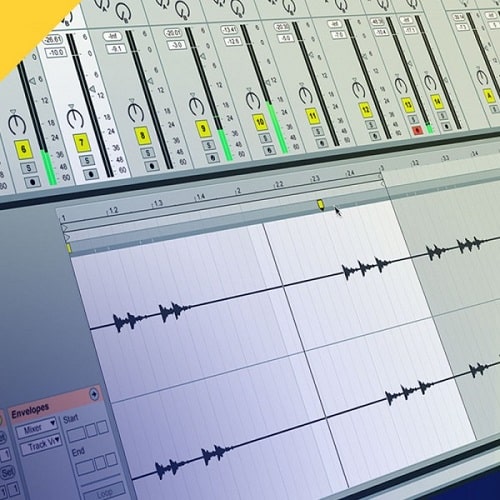Beginners Complete Guide to Ableton Live Course
This Complete Beginners Guide to Ableton Live online course provides students with all the knowledge necessary to start making music with Ableton Live. As well as being guided through all the main areas of the software, the modules also provide more general information about music composition, production and performance.
At the end of the course, students will have all the basic skills required to produce their own tracks, with the lessons going from setting up the software and jamming, right through to tweaking and exporting the final mix. Students are even introduced to important sound creation methods, such as sampling and synthesizing, the latter with Novation’s included classic Bass Station software synth.
To get a feel for the course, check out the contents tab where you can view the twenty minute long, totally free sample module.
Modules in this course:
Module 1 – Introduction to the Course and Live Basic Concepts
Introduces the course style and preferred working methods then moves onto the first steps with Live, beginning with the preferences and setting up and then moving onto the software modes, layout, file management and the Browser, analysis files, audio formats and Project folders.
Module 2 – Playing Audio Clips in Session View Mode
Covers how to play audio clips together by triggering, arranging, copying and pasting. Then looks at tempo control and global quantisation. Also basic clip editing, such as warping, setting of start and end positions, looping. Grooves and Key mapping are also introduced.
Module 3 – How to Create and Edit MIDI Clips
Looks at what a MIDI clip is and the various ways it can be created, such as writing or playing. Then how to edit a MIDI clip, focussing on note length, pitch, quantisation and velocity. Also introduces overdub and shows saving of MIDI clips into the Browser.
Module 4 – Moving From Session to Arrangement View – From Playing to Producing
Shows how to create and work with Scenes, then the different ways that tracks can be shifted from Session to Arrangement view, to help better understand how one mode relates to another. Covers dragging and dropping, and recording tracks in directly, then basic layout and editing techniques as well as navigation in the Arrangement window.
Module 5 – Recording Audio
Explains the basics of audio recording, such as how to set up a track’s input and monitoring settings. Shows the metronome and various ways that audio can be recorded, such as with a count-in or using record punch in and out. Also shows the handling and editing of recorded audio, including scrubbing, splitting, consolidating, non-destructive editing and the differences between editing on the track and in the clip view.
Module 6 – Processing Audio – Basic Compression and Filtering
Shows how to add one or more devices to tracks and how to manage them, then explains device presets and hot swapping. Explains the basics of compression, and provides a comprehensive guide to the most important parameters. Also introduces the concept of filtering and manipulating of frequencies.
Module 7 – Building a Drum Track
Describes the process of constructing beats using Impulse. How to import samples then how to trigger them. How to edit individual sample parameters, such as decay, pitch, panning, filtering and saturation. How to record or write in a beat, then how to edit it afterwards, as well as add processing like compression.
Module 8 – Mixing a Track
Covers working with the mixer in both the Session and Arrangement window, showing all the different parameters available. Shows equalisation, track grouping, routing, sends/returns and various mixing techniques.
Module 9 – DJing with Live
Shows how to set up tracks for DJing in the Session view. Explains more about setting beat markers and warping, then how to set up cueing of tracks, how to perform with the crossfader. Also shows how to use various audio effects like the DJ EQ and delays.
Module 10 – Basic Sampling
Explains what a sampler is and how it works. Shows how to import sounds into Simpler and then how to edit them, showing trimming, transposition and looping. Introduces envelopes, starting with amplitude envelopes and moving onto filter envelopes. Briefly shows LFO modulation and some more advanced parameters available in Sampler, such as graphical envelope editing and multi-sample keyboard mapping.
Module 11 – Introduction to Synthesizing
Explains the basics of synthesizing using the included Novation Bass Station as an example. Shows the main parameters available in each synth section, demonstrating oscillator waveforms and pitch, and envelope and LFO modulation. Ends by showing how to use this knowledge to create unique programs.
Module 12 – Basic Mastering
Explains what mastering is and shows the various stages, focussing mainly on multiband compression and limiting. Also shows Spectral Analysis and EQ, more subtle refining techniques and how to export your final track.
Module 13 – More on MIDI – MIDI Controlling and Effects
Explains more about MIDI controllers – what they are and how they can be used within Live. Shows MIDI map mode and the mapping Browser. Also covers MIDI effects, mainly focussing on the Arpeggiator.
Module 14 – Introduction to Device Racks
Explains what a device rack is, the different types available and the concept of chains and macro controls. Teaches how to build a multiband compressor using a rack and Live’s other devices. Shows some examples of Instrument Racks. Runs through Drum Racks and shows how to edit and build beats with them.

